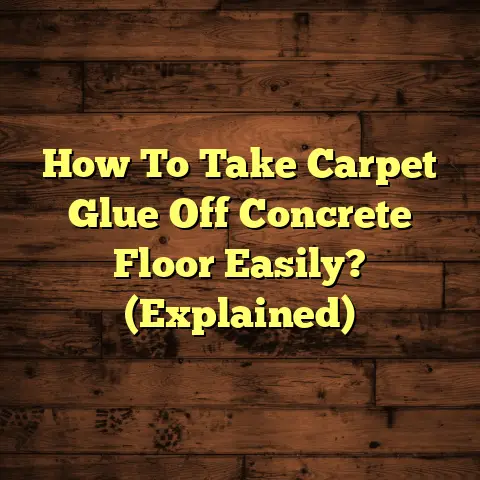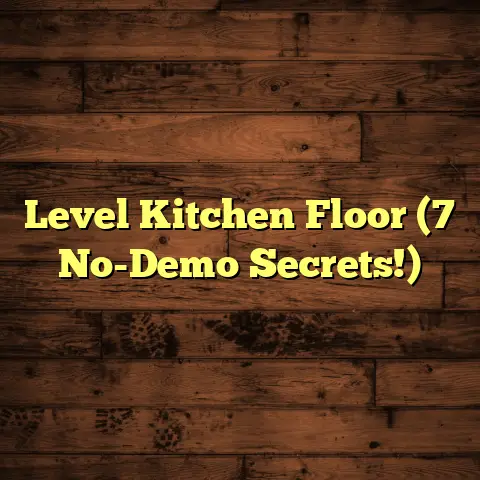Cutting Chipboard Floorboards? (7 Blade Blunders!)
Ever felt the itch to transform your living space, but the thought of another home project just makes your head spin? I get it.
Life moves fast, and squeezing in renovations can feel like mission impossible. But here’s the thing: flooring projects, especially using chipboard, can be surprisingly doable and seriously rewarding.
Chipboard’s a popular choice. It’s easy to work with and won’t break the bank. But trust me, cutting it wrong can lead to frustration. I’ve seen it all – splintered edges, uneven surfaces, and enough wasted material to build a small shed!
That’s why I’m here. I’m going to walk you through the seven most common “blade blunders” I see DIYers make when cutting chipboard floorboards. And more importantly, I’ll show you how to dodge them like a pro.
Ready to dive in? Let’s get started!
1. Understanding Chipboard and
Its Characteristics
Okay, so what exactly is chipboard?
Think of it as a wood composite, made from wood chips, shavings, and resin, all pressed together under high pressure. It’s like the “muesli” of the wood world!
Advantages:
- Affordable: It’s way cheaper than solid wood.
- Easy to install: It comes in tongue-and-groove boards that snap together nicely.
- Versatile: You can paint it, tile over it, or cover it with vinyl.
Disadvantages:
- Moisture sensitive: It swells and warps if it gets wet.
- Not as strong as solid wood: It can dent or sag under heavy loads.
- Can be dusty when cut: You’ll need a good dust mask.
You’ll often find chipboard flooring in attics, spare rooms, and under carpets. It’s a great subfloor solution. I’ve even seen it used in commercial spaces with a laminate overlay.
2. The Importance of Choosing
the Right Blade
Think of your saw blade as the chef’s knife of your flooring project. It makes or breaks the dish!
There are tons of different blades out there, but for chipboard, you want something specifically designed for wood composites.
Here’s a quick rundown:
-
Circular Saw Blades: These are your go-to for most straight cuts. Look for blades with high tooth counts (40-60 teeth) for cleaner edges.
-
Jigsaw Blades: Perfect for curves and intricate cuts. Choose a “down-cutting” blade to minimize splintering on the visible side of the board.
-
Multi-Material Blades: These can work in a pinch, but they might not give you the cleanest cut.
Blade Sharpness:
A sharp blade is everything. A dull blade tears the wood fibers instead of slicing them, leading to splintering, chipping, and a whole lot of frustration.
Why Wood Blades Matter:
Metal cutting blades are a no-go! They’re designed for metal, not wood, and will likely damage the chipboard and the blade itself.
3. Blunder #1: Using a Dull Blade
This is the cardinal sin of chipboard cutting! I can’t stress this enough: a dull blade is your worst enemy.
The Impact:
- Splintering: The edges look like a beaver went to town on them.
- Uneven Cuts: The blade wanders, and your lines go haywire.
- Burning: The blade gets hot and scorches the wood, leaving a nasty smell and discoloration.
- Increased Effort: You have to force the saw, which is tiring and dangerous.
Spotting a Dull Blade:
- The “Push Test”: If you have to force the saw through the wood, the blade is probably dull.
- Visual Inspection: Look for chipped or rounded teeth.
- Burning Smell: A telltale sign that the blade is overheating.
When to Replace:
- Regular Use: Every 20-40 hours of cutting.
- Signs of Dullness: As soon as you notice splintering or burning.
- After Hitting a Nail: Seriously, just replace it.
Pro Tip: Keep a spare blade on hand so you’re never stuck with a dull one.
4. Blunder #2: Incorrect Blade Type
Using the wrong blade is like trying to eat soup with a fork – messy and ineffective!
The Consequences:
-
Metal Cutting Blade: Will damage the chipboard and the blade. It will create excessive heat. This will cause burning and potentially dangerous kickback.
-
Coarse Wood Blade: Designed for ripping lumber. It will produce very rough, splintered edges on chipboard.
Blade Comparison:
| Blade Type | Intended Use | Results on Chipboard |
|---|---|---|
| Fine-Tooth Wood | Plywood, MDF, Chipboard | Clean cuts, minimal splintering |
| Coarse-Tooth Wood | Ripping Lumber | Rough cuts, excessive splintering |
| Metal Cutting | Metal | Damage to the blade and chipboard |
| Multi-Material | Wood, Metal, Plastic | Decent cut, but not as clean as fine-tooth |
Choosing the Right Blade:
For chipboard, you want a fine-tooth blade designed for plywood, MDF, or laminates. These blades have more teeth per inch, which results in cleaner cuts and less splintering.
5. Blunder #3: Not Securing
the Board Properly
Imagine trying to cut a piece of paper while it’s flapping in the wind. That’s what it’s like cutting chipboard without securing it!
Why It Matters:
- Safety: The board can slip, leading to accidents.
- Accuracy: The board can vibrate, making it impossible to cut a straight line.
- Quality: The board can splinter or chip if it’s not properly supported.
Securing Methods:
-
Clamps: Use clamps to hold the board firmly in place on your work surface.
-
Sawhorses: Support the board with sawhorses to prevent it from sagging or flexing.
-
Non-Slip Mat: Place a non-slip mat under the board to prevent it from sliding.
Risks of Unsecured Boards:
- Kickback: The saw can suddenly kick back towards you, causing serious injury.
- Inaccurate Cuts: The board can move during the cut, resulting in crooked lines and wasted material.
- Damage to the Board: The board can splinter or chip if it’s not properly supported.
6. Blunder #4: Ignoring
Safety Precautions
Cutting chipboard can be dusty and potentially hazardous. Don’t skimp on safety gear!
Personal Protective Equipment (PPE):
-
Goggles: Protect your eyes from flying debris.
-
Gloves: Protect your hands from splinters and cuts.
-
Dust Mask or Respirator: Protect your lungs from dust particles. Chipboard dust can be irritating and potentially harmful.
-
Ear Protection: Protect your ears from the loud noise of the saw.
Common Hazards:
- Dust Inhalation: Chipboard dust can irritate your lungs and cause respiratory problems.
- Splinters and Cuts: Chipboard can be sharp and splintery.
- Kickback: The saw can kick back towards you, causing serious injury.
- Noise Exposure: The loud noise of the saw can damage your hearing.
Mitigating Risks:
- Work in a Well-Ventilated Area: This will help to reduce the concentration of dust in the air.
- Use a Dust Collection System: Connect your saw to a dust collector to remove dust as you cut.
- Take Breaks: Rest your eyes and ears periodically to prevent fatigue.
- Stay Focused: Avoid distractions and concentrate on the task at hand.
7. Blunder #5: Inaccurate Measurements
“Measure twice, cut once” is a cliché for a reason! Precise measurements are crucial for a successful flooring project.
Why It Matters:
- Wasted Material: Inaccurate measurements can lead to wasted chipboard.
- Gaps and Mismatches: Inaccurate cuts can result in gaps and mismatches in your flooring.
- Frustration: Nothing is more frustrating than realizing you’ve cut a board too short.
Measuring Accurately:
- Use a Good Quality Tape Measure: A cheap tape measure can be inaccurate.
- Mark Clearly: Use a sharp pencil to mark your cut lines.
- Double-Check: Always double-check your measurements before cutting.
Consequences of Inaccurate Measurements:
- Short Boards: You’ll have to start over with a new board.
- Long Boards: You’ll have to trim the board, which can be time-consuming and difficult.
- Gaps and Mismatches: Your flooring will look unprofessional and unfinished.
8. Blunder #6: Failing to Test Cuts
Think of test cuts as dress rehearsals for your flooring project. They help you fine-tune your technique and avoid costly mistakes.
Why Test Cuts Are Critical:
- Blade Performance: Test cuts allow you to see how the blade is performing and make adjustments if necessary.
- Cutting Technique: Test cuts help you refine your cutting technique and ensure that you’re getting clean, accurate cuts.
- Material Compatibility: Test cuts allow you to see how the chipboard reacts to the blade and make adjustments if necessary.
Testing Techniques:
- Sample Cuts: Make a few sample cuts on scrap pieces of chipboard before cutting the actual boards.
- Adjust Settings: Adjust the saw settings (blade height, speed, etc.) as needed to achieve the best results.
- Inspect Cuts: Carefully inspect the sample cuts for splintering, chipping, or other imperfections.
Case Study:
I once worked on a project where the homeowner skipped the test cuts and ended up wasting an entire sheet of chipboard because the blade was splintering the edges. A few test cuts would have saved him a lot of time and money!
9. Blunder #7: Rushing the
Cutting Process
Rome wasn’t built in a day, and neither is a perfect chipboard floor. Rushing the cutting process is a recipe for disaster.
Dangers of Rushing:
- Inaccurate Cuts: You’re more likely to make mistakes when you’re rushing.
- Safety Hazards: You’re more likely to have an accident when you’re not paying attention.
- Poor Quality: The finished product will look rushed and unprofessional.
Tips for Maintaining Focus:
- Take Breaks: Take regular breaks to rest your eyes and clear your head.
- Stay Hydrated: Drink plenty of water to stay focused and alert.
- Listen to Music: Put on some music to help you relax and stay motivated.
- Avoid Distractions: Turn off your phone and avoid other distractions.
Benefits of a Methodical Approach:
- Accurate Cuts: You’ll be more likely to make accurate cuts when you take your time.
- Safety: You’ll be less likely to have an accident when you’re paying attention.
- High Quality: The finished product will look professional and well-crafted.
In Conclusion:
So there you have it – the seven deadly blade blunders that can derail your chipboard flooring project. Remember, cutting chipboard doesn’t have to be a nightmare. With the right tools, the right techniques, and a little patience, you can achieve professional-looking results and transform your space into something you’re proud of.
Now go forth and conquer those chipboard floorboards!
And hey, if you ever get stuck, don’t hesitate to reach out. I’m always happy to help a fellow DIYer out. Happy flooring!





